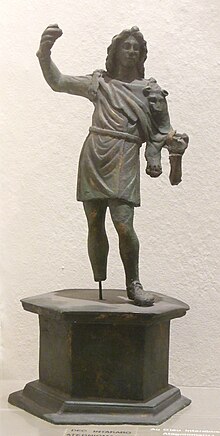Intarabus

Intarabus was a Gaulish god in the pantheon of the Treveri and some neighbouring peoples. His name is known from nine inscriptions from a relatively compact area in what are now Belgium, Luxembourg, western Germany and eastern France.[1] He may have been the tutelary deity of one of the three pagi (subdivisions) of the Treveri.[2] In most cases, Intarabus is invoked alone – without any synthesis to a Roman deity, and without accompanying female deities. However, one inscription invokes him as Mars Intarabus, noting that a fanum and simulacrum of this god had been restored at Trier.[3][4] Meanwhile, another inscription from Mackwiller in Alsace gives Intarabus the epithet Narius.[5] An inscription at Ernzen in Germany has his name as [In]tarabus,[6] while another from Foy-Noville (now within the town of Bastogne in Belgium), invokes Entarabus in conjunction with the Genius Ollodagus.[7]
A bronze statuette from the Foy-Noville site, identified on the base as Deo Intarabo (in the dative case), depicts the god as a beardless, long-haired man in a tunic, draped with a wolf skin.[8] His raised right hand would presumably have held a spear or some other implement, while his left hand, extended at waist length, is now missing.[9][10]
The theatre at Echternach appears to have been dedicated to Intarabus,[11][12] as was an aedicula at Ernzen.[13] A silver ring engraved simply with the name Intarabo (again, in the dative case) was found at Dalheim.[9]
According to Helmut Birkhan, the site at Mackwiller reveals a number of evolutions in the local cult. Starting in the 1st century CE, there was a sanctuary for Narius Intarabus related to worship at a local spring. In the 2nd century CE, a mithraeum was built there, and inscriptions testify to the common worship of Mithras and Narius Intarabus. In the second half of the 3rd century, the mithraeum was replaced with a traditional Gaulish-style temple, which now enclosed the sacred spring. From this it can be seen that the Mithraic cult was abandoned in favour of the older Celtic local deities.[14]
The name ‘Intarabus’ has been characterized as “etymologically obscure”;[15] Xavier Delamarre, however, takes the name to mean entar-abus "Entre-Rivières" (between rivers).[16]
References
- ^ Nicole Jufer & Thierry Luginbühl (2001). Les dieux gaulois : répertoire des noms de divinités celtiques connus par l'épigraphie, les textes antiques et la toponymie. Paris: Editions Errance. ISBN 2-87772-200-7. (in French)
- ^ Ton Derks (1998). Gods, Temples and Ritual Practices: The Transformation of Religious Ideas and Values in Roman Gaul. Amsterdam University Press. ISBN 978-90-5356-254-3. p.199.
- ^ CIL XIII, 03653
- ^ Joan Carbonell Manils and H. Gimeno Pascual. "Un fanum in Turgalium". p.15. In Faventia 27/2, 2005. (in Spanish)
- ^ AE 1957, 0155b
- ^ AE 1978, 0513
- ^ CIL XIII, 03632
- ^ David Colling (2011), La statuette d'Intarabus de Foy-Noville, Annales de l'Institut Archéologique du Luxembourg, 145, p. 83-89, ISSN 0776-1244
- ^ a b Drawing of the ring and descriptions as given on a wall plaque at the Musée national d'histoire et d'art, Luxembourg.
- ^ Jean-Luc Bodeux. « Fabuleux bestiaire d'Ardenne[permanent dead link] ». Le Soir, 23 August 2006. (in French)
- ^ CIL XIII, 3653
- ^ Frank Sear (2006). Roman Theatres: An Architectural Survey. Oxford University Press. ISBN 978-0-19-814469-4. p.210.
- ^ Weihedenkmal des Gottes Intarabus in Ernzen Archived 2007-08-30 at the Wayback Machine and Kulturgüter in der Region Trier Archived 2007-09-26 at the Wayback Machine, both concerning reconstructed monuments to Intarabus at Ernzen (with photographs). (in German)
- ^ Helmut Birkhan: Kelten. Versuch einer Gesamtdarstellung ihrer Kultur. p. 280.
- ^ Bernhard Maier (1998). Dictionary of Celtic Religion and Culture. Boydell & Brewer. ISBN 978-0-85115-660-6. p.158.
- ^ Xavier Delamarre (2003). Dictionnaire de la langue gauloise : Une approche linguistique du vieux-celtique continental, 2e édition. Éditions Errance. ISBN 2-87772-237-6. pp.29, 162. (in French)


